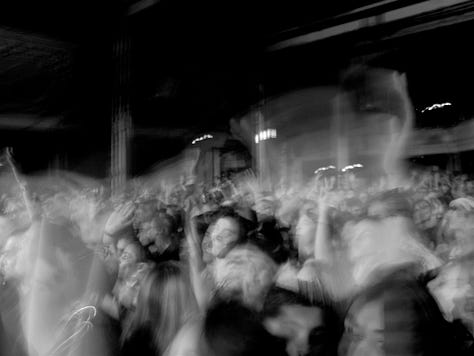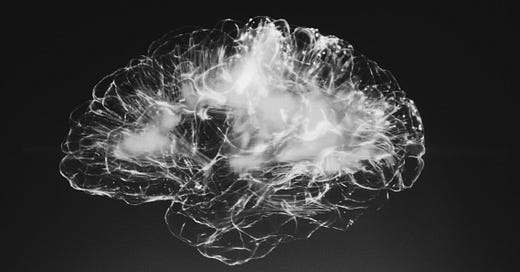Chapter 7: Brains, Beauty, and Something Like Awe
Where Creativity Lives
We’ve all heard it: “I’m more right-brained” or “She’s left-brained and analytical.” It’s a tidy way to make sense of how we think—but neuroscience tells a far more intricate (and interesting) story.
The idea that the right hemisphere governs creativity while the left handles logic is a popular myth, but it's been widely debunked by researchers. While some functions—like language—tend to be more lateralized, creativity is not housed in one hemisphere. It’s a whole-brain process, drawing on networks that span memory, emotion, abstraction, and pattern recognition.
Studies using brain imaging (like fMRI) show that creative thinking activates regions across both hemispheres. In a 2013 study published in PLOS ONE, researchers found no evidence that people are "left-brained" or "right-brained"—instead, both hemispheres work together during cognitive tasks (Nielsen et al., 2013).
More recent research by cognitive neuroscientist Roger Beaty reveals that creativity draws on three key brain networks working in concert:
The default mode network, active when we’re daydreaming or imagining, is responsible for generating original, unconstrained ideas.
The executive control network, which handles focus, planning, and self-monitoring, helps shape and refine those ideas.
And the salience network, which evaluates emotional relevance and novelty, acts as a switchboard—determining which ideas are worth exploring further (Beaty et al., 2015).
Perhaps not surprisingly, it turns out that experience shapes brain use. Skilled musicians or artists may rely more on left-hemispheric pathways when engaging in creative work that involves well-learned routines, while more improvisational or emotionally expressive tasks may engage the right hemisphere (Dietrich, 2004).
In short: creativity doesn’t live in one part of the brain—it lives in the connections. It's less about sides and more about synergy.
And so, it turns out: creativity isn’t fixed, and neuroscience confirms that we can foment and strengthen the brain’s creative networks with intention and practice. How?
New and varied experiences—especially those that challenge assumptions—help strengthen connectivity between the default mode and executive control networks (Beaty et al., 2018).
Deliberate mind-wandering (with the ability to refocus) engages both ideation and evaluation processes, increasing creative output (Christoff et al., 2009).
Meditation and mindfulness practices enhance the salience network, improving cognitive flexibility and the ability to shift between internal and external attention (Tang et al., 2015).
Creative training, like improvisation or expressive writing, measurably strengthens the connectivity between these networks (Fink et al., 2010).
In other words, we can practice creativity neurologically, not just artistically. Each time we let our minds roam, reframe a problem, or try something unfamiliar, we’re not only being creative, we’re building the scaffolding for more creativity to come. So this month, instead of thinking about left vs. right, what if we honored the richness of the middle? The unpredictable, electric space between intuition and intellect, structure and surprise.
Listenin’ & Readin’
Because sometimes a good paragraph hits harder than a green juice.
📖 How to Fail at Almost Everything and Still Win Big by Scott Adams
Best known as the creator of the Dilbert comic strip, Adams steps out of cartoon panels and into personal philosophy. Part memoir, part mental reframe, the book argues that goals are fragile but systems are resilient; that passion is overrated, but personal energy is the real compass. The standout idea: “skill stacking”—becoming above average at multiple things to compound your odds of success. A refreshingly unconventional take on ambition, failure, and how to set yourself up so luck is more likely to find you.
🎧 Honestly with Bari Weiss
Episode: How to Examine Your Marriage—and Your Life
Bari Weiss sits down with philosopher Agnes Callard, who shares a deeply unconventional story: she divorced her husband, married her lover, and now cohabitates with both men, raising children together under one roof. It's a radically honest exploration of love, partnership, divorce, and change, and what emerges is less a sensational tale and more a meditation on partnership, reinvention, and what it means to live an examined life. A provocative listen that will linger with you.
🎧 The Ezra Klein Show
Episode: Is This America’s Golden Age? A Debate
In the spirit of healthy debate, Ezra Klein, Ben Rhodes, Kevin Roberts, and Kellyanne Conway argue about whether America is in a modern “golden age.” The conversation spans optimism, national identity, economic narratives, and the soul of a country in flux. It covers everything from institutional trust and the balance of power, to culture and policy—as well as some philosophizing on a nation's "virtue." It is rare to enjoy a debate as much as I enjoyed this one; you may not agree with every take, but you'll come away sharper for having listened.
This Month’s Nudge






Of Grief & Grace
Grief has had a myriad ways of showing up recently. It’s not the dramatic kind, but much quieter—the kind that drips, not crashes. That gathers in corners. That doesn’t have a name or a headline, just a weight that sometimes surprises you in the middle of the afternoon. Ambient grief. Accumulated grief. The kind that doesn’t announce itself but rearranges you anyway.
And yet, even here—sometimes especially here—there’s also a doorway to something else. Not silver linings. Not forced meaning. But the privilege of heightened contrast: collateral beauty, the unexpected, unsummoned grace that lives alongside the ache. Like the way everything in the foreground seems brighter, more acute, against the darkening sky right of a storm.
Like, have you ever...
seen early sun filter through a curtain and suddenly make dust look like confetti?
watched a toddler hand a sticker to a stranger in the checkout line?
walked past a tree the moment a single leaf let go?
noticed how wind lifts the edge of a tablecloth on a quiet patio—a small invitation?
caught someone humming to themselves on the subway, unaware, unafraid?
cooked in silent synchronicity with someone you love?
watched two people lean into each other without realizing?
Yes, grief is a long conversation—but, have you ever:
seen someone stop traffic to help an animal cross the road?
witnessed a stranger lunge to help someone without hesitation?
had the perfect bite of food?
heard a voice crack mid-song because the feeling got too big to hold?
watched someone laugh uncontrollably for the first time in a long time?
realized you never tire of someone’s presence?
felt a Sunday kind of love?
Grief doesn’t just take. It quietly, awkwardly, but insistently opens a million tiny windows through which, if we let it, comes something like awe. Not because one feeling replaces another, but because it reminds us of the ineffable interdependence between them. It strips us of our own masks and asks us to step into each morning saying:
yes, and
this, too.
So this month’s nudge is: if the air feels heavier for you lately, see what else it’s carrying. Let grief sharpen your attention to the invisible tenderness threaded through ordinary moments. Call out the collateral beauty it brings forth. Let it break you open—not just to pain, but to presence. “The wound is where the light enters you.” (Rumi)
And when words run out, let poetry take over.
Gravity
Everything falling is beautiful,
like fruits dropping,
sunlight ripened into sugar,
and girls tripping,
distracted, daydreaming;
even a city,
collapsing onto itself,
has its own collateral beauty,
aflame.
Creative Curiosities
The Pulse Beneath the Canon
I first saw Joaquin Horsley perform at a Nu Deco Ensemble concert years ago—an unexpected jolt of joy, precision, and emotional wildness. Since then, his work has stayed with me. Composer, pianist, and orchestrator, Horsley doesn’t just reinterpret music—he fuses classical foundations with Afro-Cuban rhythm, creating something that feels both rooted and entirely new.
Best known for his Beethoven in Havana series, he blends classical Western canon with Afro-Cuban percussion, translating loss, celebration, and awe into rhythm. His music is what happens when something sacred breaks apart—and is rebuilt with even more life inside it. Horsley calls it “musical diplomacy.” I think of it as a reminder: the cracks don’t ruin the song—they let the rhythm in.
One of my favorite pieces is featured in the video below: Nu Deco Ensemble performs "Lacrimoson", a reimagining of Mozart’s Lacrimosa infused with Cuban rhythms, arranged by Horsley and conducted by Jacomo Bairos. I have several favorite moments, but there’s a section around 2:17 that I return to often. Watch the performance above.
→ And if you're curious:
🎹 Beethoven in Havana – a thunderclap of cello, conga, and clarity.
💽 Via Havana (full album) – equal parts elegance and pulse.
Morsel of Inspiration
“Even after all this time, the sun never says to the moon, ‘You owe me.’ Look what happens with a love like that—it lights the whole sky.” — Hafiz
Until next time, stay wide.




